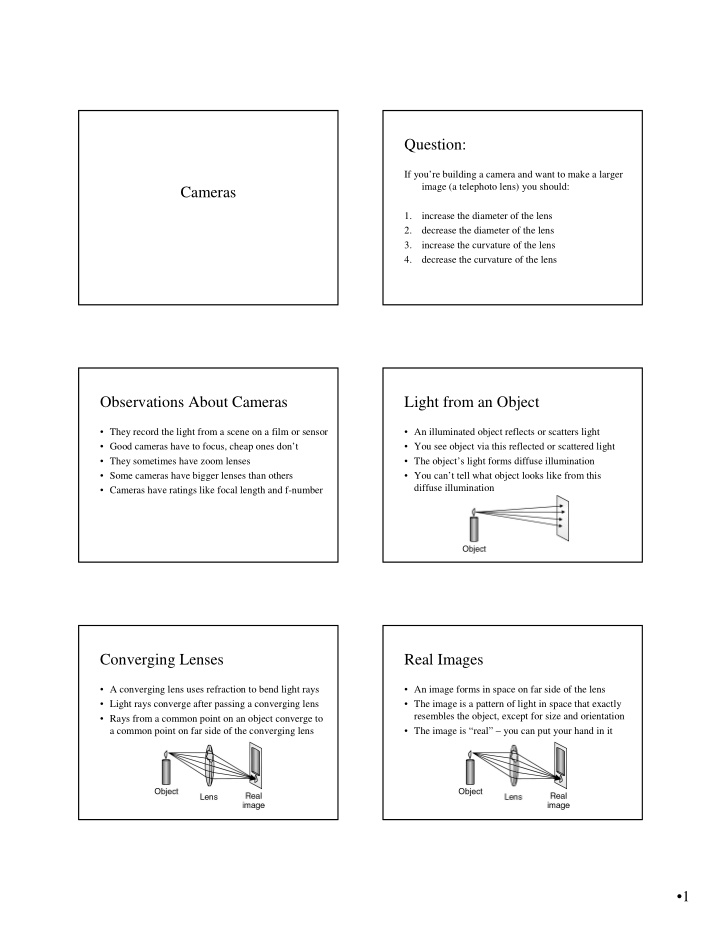



Question: If you’re building a camera and want to make a larger image (a telephoto lens) you should: Cameras 1. increase the diameter of the lens 2. decrease the diameter of the lens 3. increase the curvature of the lens 4. decrease the curvature of the lens Observations About Cameras Light from an Object • They record the light from a scene on a film or sensor • An illuminated object reflects or scatters light • Good cameras have to focus, cheap ones don’t • You see object via this reflected or scattered light • They sometimes have zoom lenses • The object’s light forms diffuse illumination • Some cameras have bigger lenses than others • You can’t tell what object looks like from this diffuse illumination • Cameras have ratings like focal length and f-number Converging Lenses Real Images • A converging lens uses refraction to bend light rays • An image forms in space on far side of the lens • Light rays converge after passing a converging lens • The image is a pattern of light in space that exactly resembles the object, except for size and orientation • Rays from a common point on an object converge to a common point on far side of the converging lens • The image is “real” – you can put your hand in it •1
Lenses and Film Focusing • Film records the pattern of light it’s exposed to • Light reaching the lens from an object is diverging • If you put film in a real image, it will record a • The nearer the object, the more its light diverges pattern of light resembling the object • Converging lens has trouble with diverging light • For a good photograph, the real image should be – Real image of nearby object forms farther from lens sharply focused on the film and have the right size – Real image of distant object forms closer to lens 1 1 1 + = Object distance Image distance Focal length Focal Length Lens Diameter • Focal length measures the lens’ converging ability • Larger lens – Long focal length: weak convergence, long image distance – converges more light – Short focal length: strong convergence, short image distance – brighter image – focus becomes more critical • The larger the object distance, the bigger the image – less depth of focus – Long focal length: big images • Smaller lens – Short focal length: small images – dimmer image – focus becomes less critical – more depth of focus Question: Wide Angle vs Telephoto If you’re building a camera and want to make a larger • Wide angle lens image (a telephoto lens) you should: – Highly curved to converge rays quickly and focus close – Bright, small image forms near lens – Small diameter lenses are usually adequate 1. increase the diameter of the lens • Telephoto lens 2. decrease the diameter of the lens – Weakly curved to converge rays slowly and focus far 3. increase the curvature of the lens – Dim, large image forms far from lens 4. decrease the curvature of the lens – Large diameter lenses are usually necessary •2
Aperture or f-number Lens Flaws • Dispersion → different colors focus differently • Aperture characterizes the diameter of the lens – Use low-dispersion glass (fluoride glasses) • F-number is lens focal length divided by lens diameter – Use multi-piece lenses or “achromats” • Large f-number • Reflections → fog in photographic images – Dim image – Use antireflection coatings – Large depth of field/focus (focus is forgiving) • Spherical aberration → imperfect focus • Small f-number • Poor focusing off axis → coma distortions – Bright image • Spherical focus projected on flat film → Astigmatism – Small depth of field/focus (focus is critical) – Use aspheric lenses Black and White Film Color Film • Light exposure creates a latent image • Sensitizers and filters produce three latent images – Silver bromide grains absorb photons (a silver salt) – Sensitizers and filters are built into the film – Photon energy separates salt into silver and bromine – Latent images are sandwiched together in the film – If a 4 atom silver cluster forms → grain will develop – Layers record red, green, and blue light respectively – Gold sensitization reduces threshold to 2 silver atoms • During development, colored dyes are produced • Development converts exposed salt grains to silver – Spent developer causes dye molecules to form – Red layer: cyan, blue layer: yellow, green layer: magenta • Silver particle is misshapen and appears black • Dyes form a negative image of exposing object • Film forms a negative image of exposing object Digital Cameras • Instead of film, use CCD imaging chip • Chip is divided into tiny squares or pixels • Photon causes charge transfer in pixel • After exposure, pixels retain charge image • Charge is shifted out of pixels using MOSFETs • Camera obtains and saves image •3
Recommend
More recommend